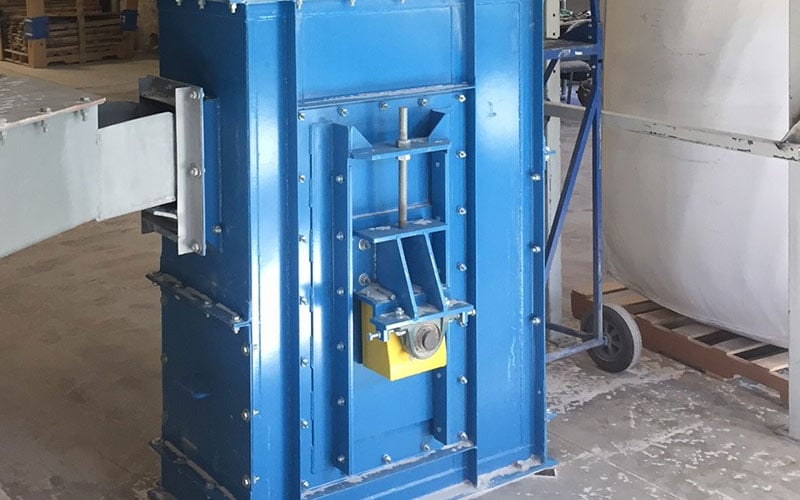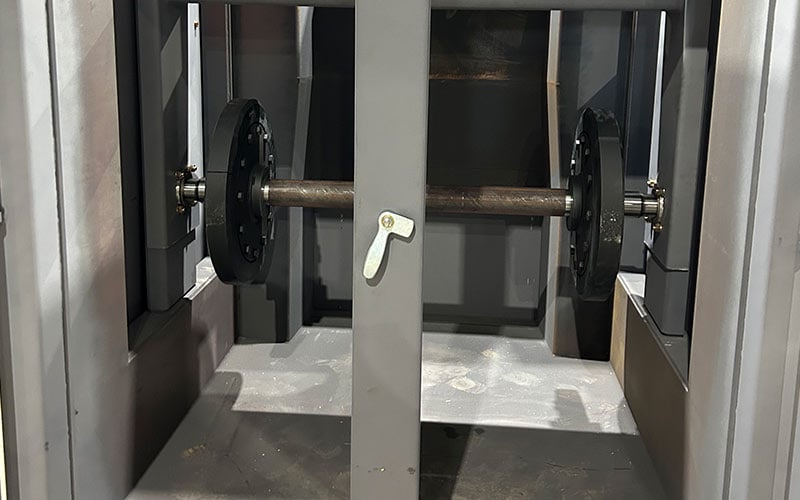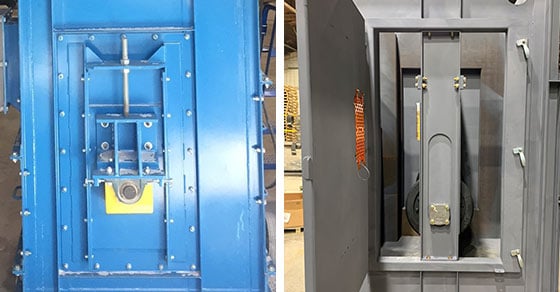Bucket elevators employ a take-up assembly to “take up” any slack in the belt or chain, ensuring proper tension of the belt or chain around the head and tail pulleys or sprockets.
While producers have a few options available to them when selecting take-ups for their belt conveyor systems, bucket elevators are a little less flexible.
The following covers the two types of take-ups available for use in bucket elevators, how each type works, and the advantages and disadvantages to each. As will be shown, the type of take-up is almost always dictated by the application.
Why Proper Belt/Chain Tension is Important
Achieving the right amount of tension around pulleys or sprockets is critical to elevator operation whether the unit is driven by a belt or chain. In both cases, proper tension ensures that the elevator can operate as designed with minimal wear on the belt or chain. As such, proper tension promotes maximum belt/chain service life.
An over-tensioned belt or chain risks degradation and premature failure, while also putting added stress on the head and boot pulleys or sprockets and other drive components.
In contrast, an under-tensioned belt could allow slipping on the head pulley, preventing the unit from operating properly and even resulting in frequent upsets.
The two primary take-up types available for managing tension in bucket elevators are the screw take-up and gravity take-up, or GTU. Although in some cases both may be an option, in general, these two types of take-ups are suited for different settings.
Screw Take-Ups
A screw take-up consists of a threaded rod/screw on each side of the boot pulley. The screws are manually adjusted in equal measure to raise or lower the height of the boot pulley/sprocket, in turn increasing or decreasing tension on the belt or chain.
Zero-speed switches can be mounted on the boot shaft in order to alert operators in the event that the shaft stops moving, giving the operator valuable time to respond.
Screw take-ups utilize a typical two-bolt ball bearing, but can be customized with different bearing seals. The shaft is sealed to the boot casing with a split gland-type seal.
The screw take-up is primarily used with belt-style bucket elevators, though it can also be a cost-effective option on small-capacity chain elevators (larger chain elevators require a floating take-up system due to the extreme forces experienced by the chain).

Boot section of a bucket elevator with screw take-up
Advantages
The screw take-up offers a simple, cost-effective approach to managing belt (or chain) tension.
Disadvantages
Because they require manual adjustment, screw take-ups are externally mounted for easy access. This means that the boot shaft penetrates the casing, creating the opportunity for fugitive material to escape the system.
Further, the manual adjustment required by the screw take-up can increase the potential for human error, such as overtightening or forgetting to periodically check if adjustment is needed.
Gravity Take-Ups (GTUs)
A gravity take-up works by floating the boot shaft in a slotted frame and using the weight of the take-up assembly (shaft, sprockets, take-up frame) to provide tension. This type of take-up is standard for chain elevators. Low-capacity single chain elevators may use a screw take-up, however all larger single chain elevators and dual chain super capacity elevators require a GTU.
A GTU is not appropriate for use with belt-driven elevators. Belt elevators require friction to avoid slipping, so a constant force must be applied on the belt to maintain proper tension on the head pulley.
Because the boot shaft does not penetrate the boot casing with this type of take-up, the two bolt ball bearings used on screw take-ups are not compatible with gravity take-ups. Instead, GTU’s use a hard iron or Ni-Hard block and sleeve type bearing. They are internal to the boot casing, require no lubrication, and can be serviced or replaced from an access door.

Interior view of elevator boot section with gravity take-up
An optional bucket motion sensor can be incorporated into the casing to alert operators in the event that buckets stop moving.
Advantages
Gravity-style take-ups offer several advantages.
In addition to accommodating higher capacities, this take-up style requires little-to-no maintenance and is largely self-monitoring. Once it is properly set up, it manages chain tension automatically, eliminating the need for human-equipment interaction.
Another advantage of the gravity take-up is that unlike the screw take-up, it is completely contained within the sealed boot casing, preventing any potential for material leakage at this point. For this reason, this take-up style is ideal for settings where fugitive dust must be kept to a minimum.
Disadvantages
Because of its more complex build, the gravity style take-up is more costly than the screw take-up style and in settings where it’s not required, is considered an upgrade. However, the more robust build, lack of fugitive material, and ease of maintenance are often more than worth the expense.
The following table summarizes the key differences between these two types of take-up assembly.
| Screw Take-Up | Gravity Take-up | |
| Best for | Belt Bucket Elevators or Low-Capacity Chains | Chain Bucket Elevators |
| Advantages | Lower cost | Extremely robustEliminates potential for material leakageSelf-monitoring & adjusting (minimal human interaction)Minimal maintenance |
| Disadvantages | Not as robustRequires manual adjustment (more human-equipment interaction)Creates potential for material leakage | Higher cost |
Conclusion
The ability to properly manage belt or chain tension around pulleys or sprockets is an essential aspect in ensuring proper operation and maximizing belt or chain service life in bucket elevators. As such, selecting the appropriate take-up assembly is critical to long-term reliability.
FEECO has been a trusted bucket elevator manufacturer since 1951. For more information on selecting the appropriate take-up or other elevator design considerations, contact us today!



